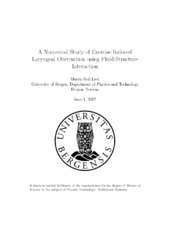A Numerical Study of Exercise Induced Laryngeal Obstruction using Fluid-Structure Interaction
Master thesis
Permanent lenke
https://hdl.handle.net/1956/16062Utgivelsesdato
2017-06-20Metadata
Vis full innførselSamlinger
Sammendrag
During inhalation, the pressure in the lungs decreases relative to the atmospheric air pressure, so that the atmospheric air is sucked into the lungs. During strenuous exercise, exposed individuals may experience that the epiglottic folds collapse due to the ventilation-induced inspirational pressure difference. Consequently, a partially blockage of the narrowest part in the respiratory tract, i.e. in the larynx, occurs. Hence, less air reaches the lungs and breathing gets harder. The above-described phenomenon is known as exercise induced laryngeal obstruction (EILO). As it is not well explored, numerous questions related to diagnosis and treatment still remains to be examined. A better knowledge of physical parameters being critical for individuals experiencing EILO is of particular interest. Hence, a better understanding of why some individuals are affected while others are not, is desirable. This thesis is based on results from a previous master's thesis with the aim of taking the work a step further. By using the commercial computational fluid dynamics software STAR-CCM+, the fluid-structure interaction method was implemented to a simplified geometrical 3D-model to balance the fluid forces and the elastic forces interacting in the breathing process. The constant lung suction pressure explained above acts as the driver of the air flow. Various values for Young's modulus were assigned to the epiglottic fold, acting as the main obstacle causing the situation arising in the larynx during EILO. Investigation of how different values for Young's modulus of the epiglottic fold affect the displacement of the fold, the volume flow at the outlet, i.e. the lungs, and the maximum velocity in the larynx were carried out. The results of the numerical simulations with fluid-structure interaction show a decrease in the volume flow at the outlet as the displacement of the epiglottic fold increases (Young's modulus decreases), as expected. In fact, a reduction equal to 34% is suggested as difference in volume flow reaching the lungs when comparing an EILO larynx with a normal larynx. Furthermore, the steady maximum velocity in the larynx was reduced with increasing displacement of the epiglottic fold in simulations where the pressure drop controls the flow. Based on the steady-state velocity data, individuals having Young's modulus of the epiglottic fold lower than 0.8 MPa were suggested to qualify as EILO patients. Fatigue of the epiglottic fold was suggested as a possible cause of the situation, but such a proposal needs further investigation.
